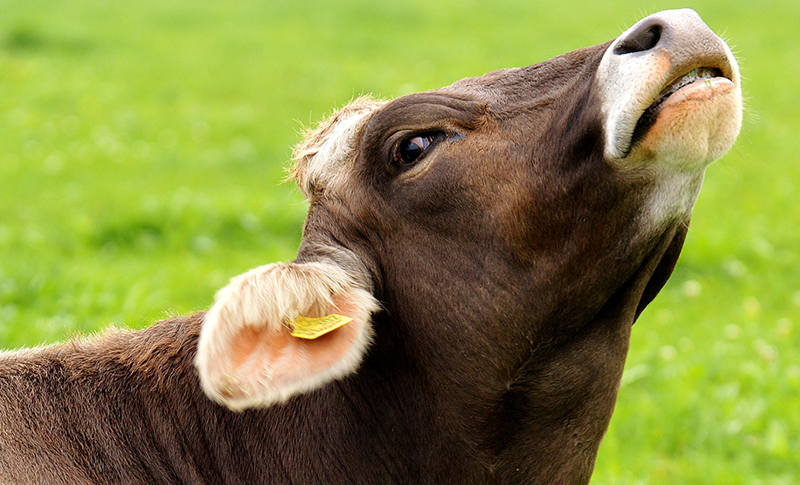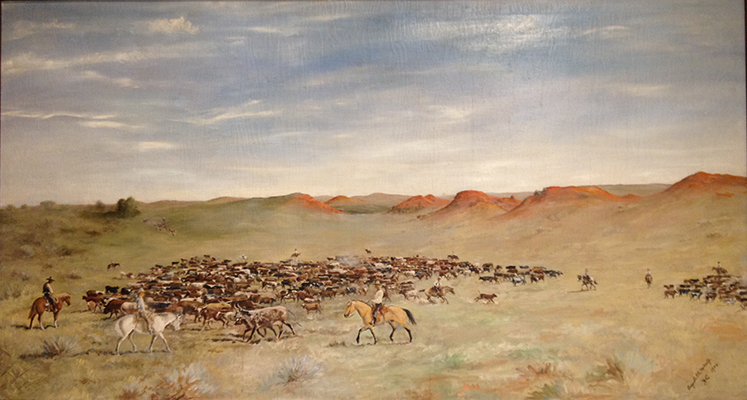Rank of Beef Cattle in Oklahoma Ag Industry
Beef Cattle

Oklahoma is Cattle Country. Everywhere you go in our state, you will see cattle grazing in fields at the side of the road. Cattle graze on Oklahoma grasslands in almost every one of our 77 counties.
Beef animals were first domesticated about 5,000 years ago . Modern domestic cattle evolved from a single ancestor, the aurochs (pronounced or-oks), an extinct wild ox species that ranged across the grasslands of Eurasia and North Africa 11,000 years ago. Domestication of aurochs gave rise to two major groups of cattle; Bos taurus and Bos indicus. Prehistoric paintings on cave walls help us see what the aurochs looked like.
Cattle are herd animals. In ancient times, herd animals were the easiest animals to domesticate. Herd animals follow the lead of a dominant member. These natural leaders are the first to cross streams, gullies and other obstacles, showing the others the way. Herd animals stay close together and move together.
The beef industry generates more income than any other agricultural enterprise in our state. In 2018, Oklahoma's beef cattle inventory was 2.2 million. That same year, Oklahoma ranked number two in the nation in the production of beef cattle, number four in the production of cattle and calves, number 9 for cattle on feed and number two for our calf crop.
A cattle and calf operation is involved mostly in producing calves to sell. Calves may be sold at auction as stockers or feeders. Feeders are sold to feed lots where they are fed until they reach a desired weight to be sold for beef production. Stockers are sold to ranchers to be placed on pasture until they reach a desirable weight to be sold as feeders. Cattle may also be sold as cows, cow/calf pairs and bulls to restock herds.
Grass is one of our most plentiful resources in Oklahoma, and most beef producers take advantage of this by grazing their cattle on pasture when it is available. Beef cattle graze many areas in Oklahoma that are unsuitable for growing crops. They transform grass, which people cannot digest, into protein (meat) that people can eat. In wheat-growing areas, cattle often graze on winter wheat in the fall and early spring. The cattle are removed from the wheat before it reaches its jointing stage to allow it to mature and ripen for harvest in late spring/early summer. When the wheat is dormant or covered with snow, supplementary feed is provided.
Just as humans need variety and balance in their diets, animals need more than just grass to stay healthy. Food eaten by animals is called "feed." Animal feed provides energy, fat, and fiber; protein for the development and maintenance of muscles and the synthesis of hormones and enzymes; and vitamins and minerals, important for the growth and maintenance of bones and other body systems.
Beef is an important part of a healthy diet for humans. About 50 separate nutrients are essential to our good health. No single food contains all of these nutrients. For this reason, dietitians and health providers recommend consuming a variety of foods daily from several different food categories. One of the nutrients you need, Vitamin B12, can be found only in animal foods, such as beef. Beef also provides significant amounts of other important nutrients—protein, riboflavin, niacin, iron and zinc.
Proteins are made up of amino acids. We need 22 amino acids, but only eight must come from food. The body can produce the others. The amino acids the body cannot make are called "essential amino acids." Proteins which contain all of the eight essential amino acids in proportions most useful to the body are called "complete" or "high quality" proteins.
Plant proteins, when eaten alone, do not contain all of the essential amino acids in sufficient quantity and therefore are incomplete. To make them complete, they must be combined with other foods containing the amino acids that are missing. For instance, beans and rice, eaten separately, do not contain all the essential amino acids, but eaten in combination, they do.
Complete proteins, such as those in beef, help to build, maintain and repair body tissues, form body hormones and enzymes and increase resistance to infection and disease.
One 3-ounce cooked serving of 80 percent lean ground beef will supply 21 grams of protein, about 45 percent of the daily amount recommended for children ages 9-13. Beef also contains significant amounts of several B-vitamins. Riboflavin (vitamin B2) helps the body use energy and promotes healthy skin and good vision in bright light. Niacin (another B-vitamin) promotes healthy skin and nerves, aids digestion and fosters normal appetite.
Learning Activities
Beautiful Bovine
Grades PreK-3: ELA, Life Science
Volunteer is dressed as a cow to demonstrate purposes of the different body parts of a cow and to show how a cow is different from a human.
- Cow Glyphs
Beef is Good for You
Grades 6-7: ELA, Math
Students read a passage about nutrients found in beef and answer comprehension questions. Students analyze nutritional information.
Beef or Dairy?
Grades K-2: ELA, Science, Math, VA
Students learn to distinguish between beef and dairy cows.
Chew It Twice
Grades 4-5: Science, ELA
The student will trace the path a cow's food follows through its body while listening to teacher-read information. Students will ask and answer questions to clarify comprehension. Students will write opinions based on text. Students will research to learn more about ruminants.
Coats and Genes - Genetic Traits in Cattle (Grades 9-12)
Grades 6-12: Science
The student will read about heredity and explore genetic traits in cattle.
- Smart Board Activity: Coats and Genes (Need help?)Please be patient with us as we learn how to use this new technology.
You must have Smart Notebook software installed on your computer to open Smart Board activities. If you have Smart Notebook software and are using Internet Explorer, you may get a message telling you the activity cannot be opened. In this event, save the activity to your hard drive. Your browser will save it as a zip file. Simply change the "zip" in the file name to "notebook," and you should be able to open it.
Thank you for your patience.
Smart Board Acitivity page
- Colorful Cattle
Great Expectations
Grade 3: Science
The student will read charts for relevant information to solve mathematical word problems.
Hot Off the Grill
Grade 7: Science
Students will observe the amounts of bacteria in Petri dishes inoculated with hamburger meat that has been cooked to different temperatures. They will also learn that cooking hamburgers to the recommended temperature of 160° F (71° C) will kill pathogenic bacteria.
Street Cows
Grades 2-4: ELA, Science
Students will learn that cows come in many different shapes and sizes and will design their own art cows after reading a story about a popular travelling art exhibit.
- PowerPoint
- Keynote
Taming the Wild Aurochs
Grades 6-High School: ELA, Science, World History
Students will read about and research the domestication of animals, including the wild aurochs, ancestor of modern cattle. Students will create a timeline of the domestication of animals.
They Don't Just Eat Grass
Grades 5-8: Math, Health, Science
Students will read about healthy feeding programs for farm animals. Students determine the best graphing method for information about animal nutrition and plot numbers provided. Students will relate information about balance in animal diets to balance in their own diets and mix their own balanced "rations."
Additional Resources
- More Facts
- Beef Cattle
- Cattle and Calves
- Books
- Fantasy and Fiction for Cows
- Nonfiction for Beef Cows
- Kahoot: Moo-ve It with Beef Cattle
- Classroom Recipes with Meat
- Songs about Cows
- Agriculture in Poetry: "The Cow"
- Agriculture in Art
- Cow in a Stable, 1845 by Jean-Baptiste-Camille Corot
- The Cow with the Subtile Nose, 1954 by Jean Dubuffet
- Highland Cattle - By the Sea, 1872 by William Smellie Watson
- Lascaux Cave Paintings, 15,000 BC
- Les Vaches (cattle), 1890 by Vincent Van Gogh
- Lying Cow, 1883 by Vincent Van Gogh
- Pasture at Deauville, 1878 by Eugene Boudin
- Roman Fountain with Cattle and Figures (Le Midi), 1645-46 by Nicolaes Berchem
- Royal Breed: One Fine Bull by Charles Banks Wilson
- The Shaw Roundup by Augusta I. Medcalfe
- Study of a Cow in a Landscape, 1758-59 by Thomas Gainsborough
- The Yellow Cow, 1911 by Franz Marc
 Augusta I. Metcalfe roped and branded calves, performed household chores, and tended to the other needs of her family's ranch operation. At the end of the day, she sketched what she had seen. This painting depicts the Shaw Ranch in Roger Mills County, near Augusta I. Metcalfe's home. (Oklahoma State Capitol Art Collection)
Augusta I. Metcalfe roped and branded calves, performed household chores, and tended to the other needs of her family's ranch operation. At the end of the day, she sketched what she had seen. This painting depicts the Shaw Ranch in Roger Mills County, near Augusta I. Metcalfe's home. (Oklahoma State Capitol Art Collection)
petersonsuind1974.blogspot.com
Source: https://oklahoma.agclassroom.org/lessons/topic_beef/
0 Response to "Rank of Beef Cattle in Oklahoma Ag Industry"
Post a Comment